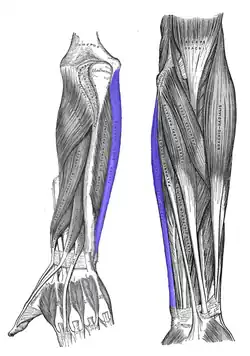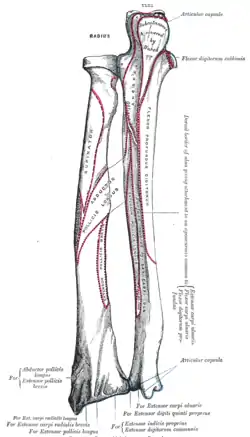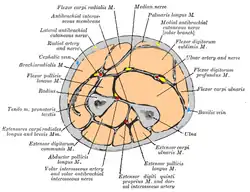Flexor carpi ulnaris muscle
The flexor carpi ulnaris (FCU) is a muscle of the forearm that flexes and adducts at the wrist joint.
| Flexor carpi ulnaris | |
|---|---|
 Dorsal (left) and ventral (right) views of deep muscles of the left forearm. The flexor carpi ulnaris muscle is in blue. | |
| Details | |
| Origin | Medial epicondyle (common flexor tendon) and medial margin on olecranon of ulna |
| Insertion | Pisiform, hook of the hamate, base of the fifth metacarpal bone (Volar Aspect) |
| Artery | Ulnar artery |
| Nerve | Muscular branches of ulnar nerve (from C8 and T1) |
| Actions | Flexion and adduction of wrist |
| Antagonist | Extensor carpi radialis brevis muscle and extensor carpi radialis longus muscle |
| Identifiers | |
| Latin | Musculus flexor carpi ulnaris |
| TA98 | A04.6.02.030 |
| TA2 | 2483 |
| FMA | 38465 |
| Anatomical terms of muscle | |
Structure
Origin
The flexor carpi ulnaris has two heads; a humeral head and ulnar head. The humeral head originates from the medial epicondyle of the humerus via the common flexor tendon. The ulnar head originates from the medial margin of the olecranon of the ulna and the upper two-thirds of the dorsal border of the ulna by an aponeurosis. Between the two heads passes the ulnar nerve and ulnar artery.
Insertion
The flexor carpi ulnaris inserts onto the pisiform, hook of the hamate (via the pisohamate ligament) and the anterior surface of the base of the fifth metacarpal (via the pisometacarpal ligament).
Action
The flexor carpi ulnaris flexes and adducts at the wrist joint.
Innervation
The flexor carpi ulnaris is innervated by the ulnar nerve. The corresponding spinal nerves are C8 and T1.
Tendon
The tendon of flexor carpi ulnaris can be seen on the anterior surface of the distal forearm. On a person's distal forearm, just before the wrist, there are either two or three tendons. The tendon of the flexor carpi ulnaris is the most medial (closest to the little finger) of these. The most lateral one is the tendon of flexor carpi radialis muscle, and the middle one, not always present, is the tendon of palmaris longus.
Function
The muscle, like all flexors of the forearm, can be strengthened by exercises that resist its flexion. A wrist roller can be used and wrist curls with dumbbells can also be performed. These exercises are used to prevent injury to the ulnar collateral ligament of elbow joint.
Variability
The muscle can be doubled as accessory flexor carpi ulnaris muscle and is often accompanied by concomitant variants.[1]
Clinical significance
Ulnar entrapment by the aponeurosis of the two heads of the flexor carpi ulnaris muscle may cause cubital tunnel syndrome.
The tendon of flexor carpi ulnaris can be used for tendon transfer.[1]
Additional images
 Bones of left forearm. Posterior aspect.
Bones of left forearm. Posterior aspect. Bones of the left hand. Volar surface showing its insertion into the pisiform bone and then via ligaments into the hamate bone and 5th metacarpal bone, acting to flex and adduct the wrist joint.
Bones of the left hand. Volar surface showing its insertion into the pisiform bone and then via ligaments into the hamate bone and 5th metacarpal bone, acting to flex and adduct the wrist joint. Cross-section through the middle of the forearm.
Cross-section through the middle of the forearm. Flexor carpi ulnaris muscle
Flexor carpi ulnaris muscle
References
- Kunc, Vojtech; Stulpa, Michal; Feigl, Georg; Kachlik, David (2019-05-29). "Accessory flexor carpi ulnaris muscle with associated anterior interosseous artery variation: case report with the definition of a new type and review of concomitant variants". Surgical and Radiologic Anatomy. 41 (11): 1315–1318. doi:10.1007/s00276-019-02261-4. ISSN 0930-1038. PMID 31144008. S2CID 169032218.
External links
- Illustration: upper-body/flexor-carpi-ulnaris from The Department of Radiology at the University of Washington